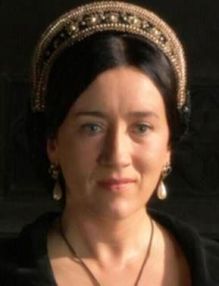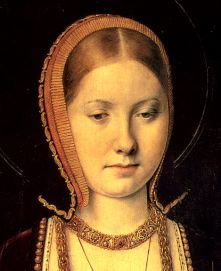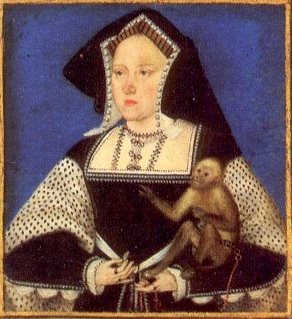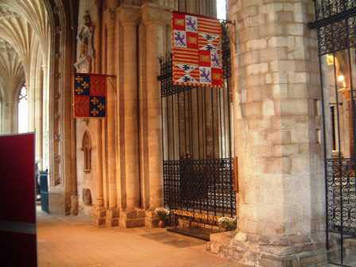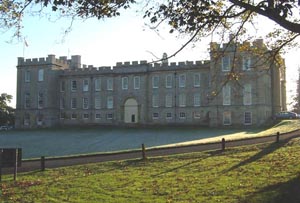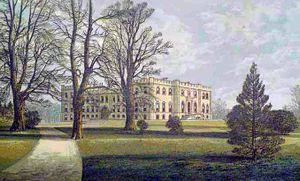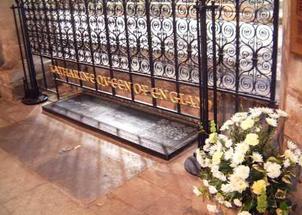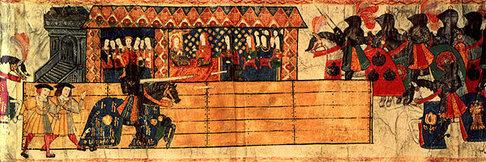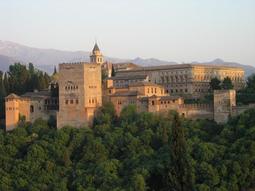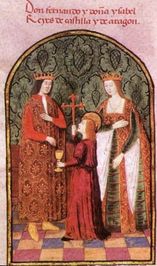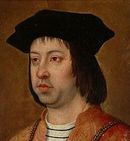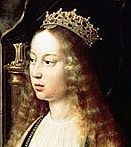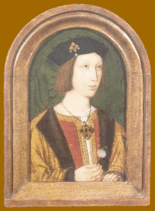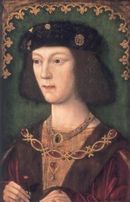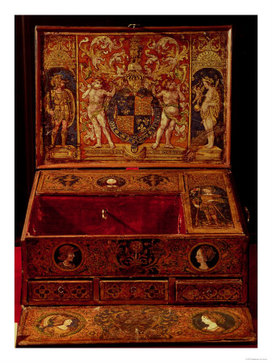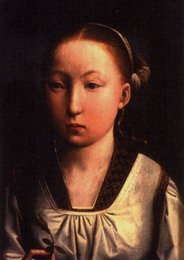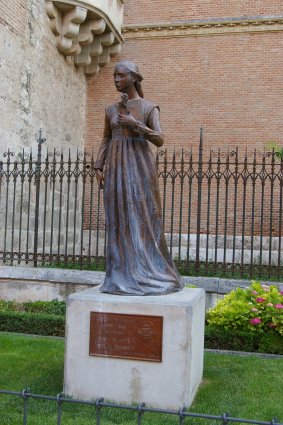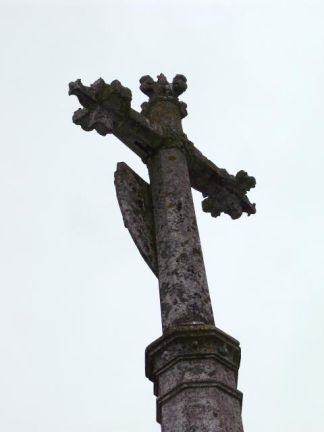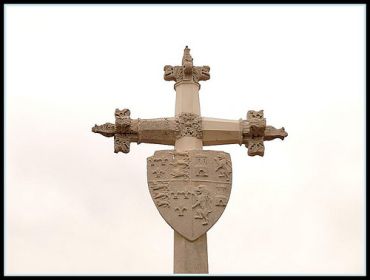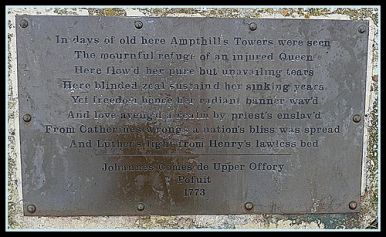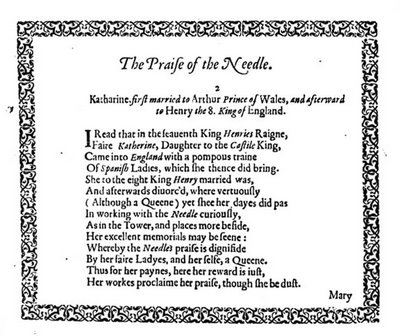Katherine of Aragon - Historical profile
Jump to navigation
Jump to search
| The History of Queen Katherine of Aragon " Queen of Hearts" 1485 - 1536 (aged 50) Queen consort 1509 till 1533 (24 yrs) Click EasyEdit to update this page! (Don't see the EasyEdit button above? <a href="../#signin" target="_self">Sign in</a> or <a href="../accountnew" target="_self">Sign up</a>.) |
| INTERESTING FACTS: - In her youth, Katherine's thick auburn hair was almost to her feet, and she let it flow loose at her wedding. However, she would go prematurely grey. -Sir Thomas More wrote: "There were few women who could compete with the queen in her prime". - Prince Arthur wrote to Katherine's parents saying : 'never felt so much joy in his life as when he beheld the sweet face of his bride'. - By all accounts, Henry's marriage to Katherine of Aragon was a relatively happy one for almost 10 years. Although there were rumours of mistresses from the first year they were married. When Katherine learned of the birth of Henry's illegitimate son by his mistress Elizabeth Blount, she was upset & humiliated and started to withdraw from court life. After 15 years of marriage Henry stopped sexual relations with her and began to doubt the validity of their marriage. (See also: the Timeline of Katherine's life) - During Henry's invasion of France in 1513 she was made regent; she showed great zeal and ardour in the preparations for the Scottish expedition, and was riding towards the north to put herself at the head of the troops when the victory of Flodden Field ended the campaign. - It is believed Katherine began to wear hair shirts after her last stillbirth in 1518.See the Tudors & Religion regarding this religious practice. - After her father Ferdinand's "treachery"in making a treaty with France roused Henry's wrath, and he took his anger out on her she took occasion in 1520, during the visit of her nephew Charles V to England, to urge the policy of gaining his alliance rather than that of France. - It is believed that she pled for mercy for Edward Stafford, 3rd Duke of Buckingham before his execution & this was recorded by Shakespeare later. - "It is likely that Henry's marriage to Katherine was celibate from 1524. Katherine had conceived many times but all of her children had died except one girl.... By the time she was 39, she had not conceived for 6 years and Henry was no longer attracted to her. .. Henry's decision to annul his marriage has often been attributed to his love for Anne Boleyn. But there is evidence from the time Katherine went through menopause that he was considering all options to secure the succession". [source: Kelly Hart's The Mistresses of Henry VIII 2009] - The Card Game Incident: There is some doubt as to whether it occurred ; it's probably apocryphal (cited by George Wyatt - based on the recollections of Nan Gainsford some 70/80 years after the events), but interesting nonetheless; '"And in this entertainment of time they had a certain game that I cannot name then frequented, wherein dealing, the king and queen meeting they stopped, and the young lady's hap was much to stop at a king; which the queen 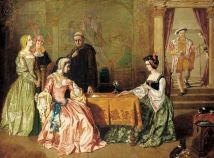 noting, said her playfellow, My lady Anne, you have good hap to stop at a king, but you are not like others, you will have all or none. So often earnest matters are delivered under game." noting, said her playfellow, My lady Anne, you have good hap to stop at a king, but you are not like others, you will have all or none. So often earnest matters are delivered under game."- During the King's great matter, Pope Clement VII actually suggested a solution that Henry would be allowed two wives, even though it is doubtful that this could have been legitimized by the pope. However, Clement was imprisoned by Charles V who obliged him to pursue a policy of delay and hesitation. - In 1532, she sent the king a gold cup as a new year's gift, which the latter returned, and she was forbidden to hold any communication with him. -Katherine was one of the most beloved foreign queen consorts of England - On the 14th July 1531, Henry left Katherine in Windsor & moved to Woodstock, never to see her again. | Queen Katherine c.1525 by Lucas Horenbout / Horenbolte. (Duke of Buccleuch Collection) This is the largest miniature of Katherine Three other miniatures exist, but two are circular copies of this original; the third is believed to be a companion piece to a miniature of the king. A unique feature of this work is that it includes Katherine's hands, something that only two other miniatures and one other portrait does. Katherine loved monkeys because they reminded her of her homeland Spain particularly the southern province of Andalusia where she lived before she left for England in 1501. <embed height="276" src="http://widget.wetpaintserv.us/wiki/thetudorswiki/page/The+Tudors+Depictions+Throughout+History/widget/unknown/-1706707728" type="application/x-shockwave-flash" width="335" wmode="transparent"/> In 1517, there was a street riot against foreigners taking the English people's jobs including Spaniards & many arrests. Katherine plead for their pardon on behalf of her adopted people & was remembered by this street ballad for her kindness: What if [she said] by Spanish blood, Have London's stately streets been wet. Yet will I seek this country's good And pardons for their children get... For which, kind queen, with joyful heart, She heard their mothers' thanks and praise, And so from them did gently part, and lived beloved all her days
| |
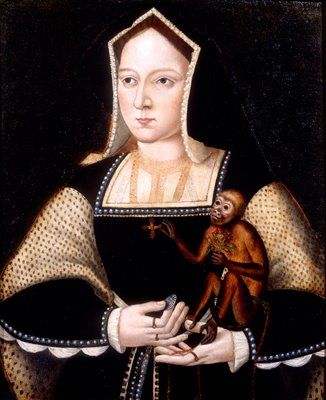 Due to recent dendrochronological dating, it has been concluded that the earliest felling date of 1531 is likely for the production of the wood panel on which this portrait is painted. Meaning this painting could plausibly be contemporary to her lifetime. Being produced in the midst of "the King's great matter" may well carry the significance that Katherine and her party may well have wanted her face to continue to be seen to maintain her status as queen.There would, therefore, have been considerable incentive for producing a portrait that showed a younger, beautiful likeness of the Queen. The portrait is derived directly from the miniature painted c.1525 by Lucas Horenbout (above right) which again shows Katherine holding a monkey, but with some subtle alterations. The monkey is being offered a coin, which he ignores, reaching out instead for the jeweled crucifix that the Queen wears at her breast. The interpretation possibly that Katherine’s pet expresses his obedience to the church by recognizing that the cross is more precious than money. The fact that these elements are absent from the Buccluech miniature, in which the monkey is merely being offered a tid-bit, and the gesture of its outstretched hand is empty, shows that the portrait’s iconography was deliberately reconfigured to comment on the Queen’s situation in the years c.1527 – 1530 and to make a point of her Catholic orthodoxy. | 'Henry and Catherine Reunited' 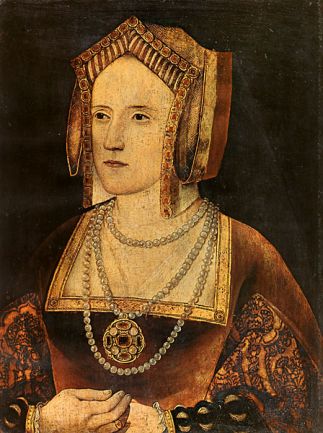 It has been identified as Queen Catherine Parr for centuries. Thanks to modern technology used to examine the portrait by the National Portrait Gallery in London, it has been concluded that the portrait is indeed that of wife no.1, Queen Katherine of Aragon. Academics working on the ‘Making Art in Tudor Britain’ project had noticed the facial features and costume worn by the woman were far more similar to works depicting the first Katherine, and dated from the 1520s or 30s. During that period of time, Catherine Parr was married to her first husband in 1527 and second in 1534. Technical analysis of the paint and the “rare” engraved frame are believed to show it was painted at the same time as a portrait of Henry VIII, with a similar style and scale. (see links for more info) 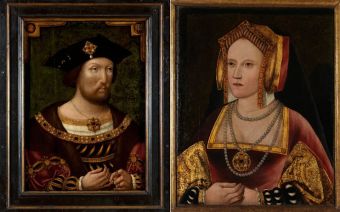 | |
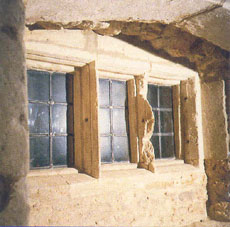 After her divorce from Henry VIII, Queen Katherine of Aragon arrived at Kimbolton Castle in May 1534. She spent the last months of her life as a prisoner in her rooms in the south-west corner of the Castle, attended by a few loyal servants. We can only guess what the rooms looked like at the time: their present appearance dates from the 18th century. After her divorce from Henry VIII, Queen Katherine of Aragon arrived at Kimbolton Castle in May 1534. She spent the last months of her life as a prisoner in her rooms in the south-west corner of the Castle, attended by a few loyal servants. We can only guess what the rooms looked like at the time: their present appearance dates from the 18th century. Parts of this building can still be seen, behind a glass panel in the wall of the Red Room and especially in the corridor near the Chapel | <embed allowfullscreen="true" height="276" src="http://widget.wetpaintserv.us/wiki/thetudorswiki/widget/youtubevideo/6c6a197f88d8a1cbd1a078c90ac927aeb0e24e20" type="application/x-shockwave-flash" width="342" wmode="transparent"/> | |
| Personality : Katherine was canny & resourceful. When a deputation headed by Cuthbert Tunstall Bishop of Durham and Dr. Lee Bishop of York came to her at Buckden to demand that she and her servants swear to the Oath of Supremacy, she told her trusted servant, Francisco Felipez to instruct the rest of her servants to appear to take the Oath by a ruse involving a play on the Spanish language which was all most of them spoke. Instead of saying that they swore that "El Rey sea hecho" (the king should be made) head of the Church of England, they were instructed to say that they swore that "El Rey se ha hecho" (has made himself) Head of the Church of England. In spoken Spanish, both sentences sound almost exactly the same, but there is a world of difference in the meaning. The commission none the wiser, departed satisfied that they had accomplished their purpose. [Luke, "Catherine the Queen pg 494] Katherine was very much an ideal queen. She was supportive of her husband, and like him, she enjoyed music and dance. As queen, Katherine managed the royal household, cared for Henry's linen and wardrobe, ran her own estates, and often supervised in royal business. She also took time and effort to provide the poor with money, clothes, food, and fuel in the winter. She was the only person Henry could confide to in the first few years of their marriage. For the first five years of their marriage, Katherine acted as the Spanish ambassador to England quite successfully on her own. She held off a Scottish rebellion in England while King Henry was off to war in France. | Comments : The Annulment in Henry's eyes It is doubtful Henry ever blamed Katherine for the failure to produce a male heir after witnessing the endless cycle of pregnancies and prayer. Yet why had he and Katherine been unable to produce a living son between them? Naturally enough and ironically for Katherine who was so religious, the king's mind turned to God. It must be God's will that they had no male heir. But what had he done to offend God? Henry searched for an answer and soon found it quite easily. In the Bible, Leviticus XVIII, 16 clearly stated 'Thou shalt not uncover the nakedness of thy brother's wife: it is thy brother's nakedness'. And, later, in chapter XX, 'If a man shall take his brother's wife, it is an unclean thing: he hath uncovered his brother's nakedness; they shall be childless'. What could be more clear? The Bible itself condemned his marriage to Katherine. And by childless of course, it meant male children. | |
| Katherine's Last Days: "Catherine had fallen seriously ill in the early winter of 1535, but she seemed to make a good recovery. In late December, however, she had a relapse and her apothercary, Philip Greenacre, wrote a hasty note to the maitre d'hotel of Chapuys's household. The Queen [as of course he persists in calling her] is very ill.....She gets worse every hour, he wrote. For two days and nights she had been unable to keep down either solids or liquids. And she had not slept more than an hour and a half 'for the pain in her stomach'. Chapuys must come immediately, 'for she has lost all her strength'. Another similar letter was written by her doctor Miguel de la Sa...... Sunday, 2 January, Chapuys arrived at the house 'before dinner' and was admitted to see Catherine immediately.... The interview was short and conducted in Spanish. Catherine thanked Chapuys for his services and for his trouble in coming to see her. It would do her good, she thought. If not, 'it would be a consolation to her to die in my arms, and not unprepared, like a beast'. In reply Chapuys tried to keep her spirits up speaking of the better houses and more generous funding which Henry had promised. above all, he assured her, ' the King was very sorry for her illness'. This was a blatant lie. But, in the circumstances, it was a justifiable one. Exhausted by the effort, Catherine asked to be left alone to sleep which she did for a few hours. At 5 o'clock, Dr de la Sa summoned Chapuys who spent more than an hour with her, alone apart from the doctor and Catherine's 'old trusty women'. .... In these conversations, Chapuys was worried about tiring Catherine. But she insisted on prolonging them and their exchanges became more and more frank...... She was worried about More and Fisher - the 'good men [who] had suffered in persons and goods ' - and about the mounting tide of heresy which threatened to engulf England. Such things were anathema to her. But they had arisen because of her steadfastness. Had she, she now asked herself been right? Or was her behaviour a mere selfish intransigence, which God was punishing by visiting these horrors on her adoptive country?...... Catherine's original doubts, however, were right. She had acted her part from the best of motives. And bearing in mind her character, she could scarcely have behaved otherwise. Nevertheless, the awful truth remains that the Reformation, and all it entailed was her work as much as Henry's and Anne's." [Source : David Starkey's Six Wives, The Queens of Henry VIII] | Katherine's Death: Ambassador Chapuys wrote to Charles V - "The queen's illness about five weeks ago....and the attack was renewed on the morrow of Christmas day. It was a pain in the stomach, so violent that she could retain no food. I asked her physician several times if there was any suspicion of poison. He said he was afraid it was so, for after she had drunk some Welsh beer, she had been worse and that it must have been a slow and subtle poison for he could not discover evidences of simple and pure poison." [source: Robert Hutchison's Thomas Cromwell] "When Catherine's body was cut open for embalming, the undertakers discovered that her heart had turned black, with a hideous growth on the outside. De la Sa was certain she had been poisoned and the accusation was later used against Anne Boleyn. But no one had access to the queen except for her most faithful ladies. Modern medical historians are certain she died of cancer. Its' interesting in the light of current "new age" thinking about the relationship between illnesses people get and their emotional condition: Catherine of Aragon died of something very close to a broken heart. [source: Karen Lindsey's Divorced Beheaded Survived; a feminist reinterpretation of the wives of Henry VIII] " For Chapuys and Catholic conspiracy theorists, it [the haste to embalm & bury Katherine] is evidence that [she] had been poisoned and that her murderers were in a hurry to conceal the deed. But these notions seem far fetched. Chamberlain and Bedingfield were simply going by The Royal Book and the procedures it described. Moreover Catherine's health had been poor even before the Divorce. And the Great Matter had imposed its own dreadful strains. In short, nature had taken its course and Catherine, in dying, had at last done what Henry wanted" [source: David Starkey's Six Wives] |
| LITERATURE Non-Fiction:
Fiction:
Queen Katherine of Aragon's Burial place in Peterborough Cathedral Queen Mary, grandmother of the present Queen, ordered that the symbols of Queenship, which included the royal banners of England and Spain be hung above Katherine's grave. [Source: Alison Weir, The Six Wives of Henry VIII, pg 301] A framed verse by William Shakespeare stands nearby: "When I am dead let me be used with honor strew me o'er with maiden flowers, that all the world may know I was a chaste wife to my grave Embalm me then lay me forth Although unqueen'd yet like a Queen and daughter to a King inter me." | Kimbolton Castle The Castle changed hands several times, and in the mid-15th century extensive building work on the inner courtyard was carried out for Ann Stafford, widow of the Duke of Buckingham. By the 1520s the Castle belonged to the Wingfield family, who had it rebuilt as a Tudor manor house. Kimbolton Castle in 1880 Death and burial: Katherine who had been in ill health since shortly after Henry banished her from court died January 7, 1536. She was attended by her best friend Maria de Salinas, who had come with her from Spain as a young woman, and her physician, Dr. de la Sa. Henry did not permit their daughter, Mary, to leave Hatfield where she was confined, to attend her mother in her last illness. Before her death, Katherine wrote to Henry a letter expressing her love and care for the future of his soul, imploring his protection for their daughter and asking payment for her attendants. She signed it with a title that she had never relinquished, 'Katherine, Queen of England'. She was accorded only the rites due to the Princess Dowager, relict of Prince Arthur and Infanta of Spain, but she remained Queen in the hearts of her subjects. The route of her funeral cortege was lined with her people who came to pay last respects to their Queen. Katherine is buried in Peterborough Cathedral. Above her grave in the north aisle is spelled in golden letters, her true title, "Katherine, the Queen" added in the 20th Century. The tomb of Katherine of Aragon in Peterborough Cathedral Note gold lettering spelling 'Katharine Queen of England'. There is hardly ever a time when it is not decorated with flowers or pomegranates, her heraldic symbol. <a class="external" href="http://www.youtube.com/watch?v=CtEtaMZ8AnU" rel="nofollow" target="_blank" title="Video clip of the commemoration of the anniversary of Katherine's funeral at Peterborough Cathedral 2010">Video clip of the commemoration of the anniversary of Katherine's funeral at Peterborough Cathedral 2010</a> |
| Henry jousting while Katherine watches, c. 1510 |
| | Katherine's parents: Ferdinand of Aragon and Isabella of Castille "The most Christan king and queen in all of Christendom" |
| Katherine's first betrothed, Prince Arthur (left) and second King Henry (right) | Coronation <a class="external" href="http://en.wikipedia.org/wiki/Image:Henry_VIII_Catherine_of_Aragon_coronation_woodcut.jpg" rel="nofollow" target="_blank" title="16th century woodcut of the coronation of Henry VIII of England and Catherine of Aragon showing their heraldic badges, the Tudor Rose and the Pomegranate of Aragon."> 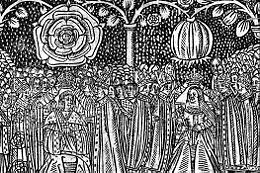 </a> </a> 16th century woodcut of the coronation of Henry VIII of England and Katherine of Aragon showing their heraldic badges, the Tudor Rose and the Pomegranate of Granada (previously a moorish territory that had been absorbed into the unified kingdoms of Aragon and Castile in 1492 during the Reconquista) . On Saturday 23 June the traditional eve-of-coronation procession to Westminster was greeted by an extremely large and very enthusiastic crowd. On Midsummer's Day, Sunday, 24 June 1509, Henry VIII and Catherine of Aragon were and anointed crowned along side each other by the Archbishop of Canterbury at a lavish ceremony at Westminster Abbey.Catherine wore a white dress with her long hair flowing loose. The coronation was followed by a banquet in Westminster Hall. Many new Knights of the Bath were created in honour of the coronation. |
| Royal Desk with Henry and Katherine's arms | A portrait believed to be of Katherine's sister, Juana of Castile, mother of the Emperor Charles V, later known as Juana la Loca (Juana the Mad), some believe it's <a class="external" href="http://www.marileecody.com/sixwivesimages.html" rel="nofollow" target="_blank">a portrait of Katherine herself</a>. by Juan de Flandes (c.1500) |
| Katherine's Siblings  Isabella of Portugal (1470-1498) Eldest child of Isabel and Ferdinand. Isabella was wedded to Manuel I of Portugal making her Queen Consort of Portugal. She died while giving birth to her only child, a son, Miguel de Paz (1498-1500). Isabella of Portugal (1470-1498) Eldest child of Isabel and Ferdinand. Isabella was wedded to Manuel I of Portugal making her Queen Consort of Portugal. She died while giving birth to her only child, a son, Miguel de Paz (1498-1500).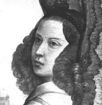 Juan of Austerias (1478-1497) Only surviving son of Isabel and Ferdinand. Juan was wedded to Margaret of Austria in April of 1497, he would die six months later from consumption. No surviving children. Juan of Austerias (1478-1497) Only surviving son of Isabel and Ferdinand. Juan was wedded to Margaret of Austria in April of 1497, he would die six months later from consumption. No surviving children. | Katherine's Siblings 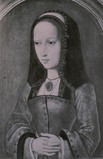 Juana I of Castile (1479-1555) Second daughter of Isabel and Ferdinand. Juana was married to Phillip the Handsome, they had six children, including Charles V and Eleanor of Hapsburg. When her mother died Juana was to become queen regent of Castile, her father would not accept this but many considered Juana queen none-the-less. When her son Charles turned 20, power was turned over to him. Juana would then spend the rest of her days under house arrest by children due to her supposed mental instability. Juana I of Castile (1479-1555) Second daughter of Isabel and Ferdinand. Juana was married to Phillip the Handsome, they had six children, including Charles V and Eleanor of Hapsburg. When her mother died Juana was to become queen regent of Castile, her father would not accept this but many considered Juana queen none-the-less. When her son Charles turned 20, power was turned over to him. Juana would then spend the rest of her days under house arrest by children due to her supposed mental instability. 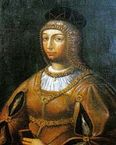 Maria of Aragon (1482-1517) Third daughter of Isabel and Ferdinand. Maria was the second wife of Manual I of Portugal, making her Queen Consort after her sister Isabella's death. She and Manuel would have 9 children. Her son John III succeeded his father as King of Portugal. Maria of Aragon (1482-1517) Third daughter of Isabel and Ferdinand. Maria was the second wife of Manual I of Portugal, making her Queen Consort after her sister Isabella's death. She and Manuel would have 9 children. Her son John III succeeded his father as King of Portugal. |
| <a class="external" href="http://www.flickr.com/photos/laurence-helene/201638264/" rel="nofollow" target="_blank" title="Christ Church Gate"> 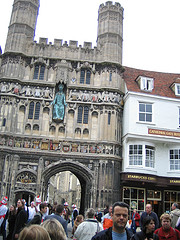 </a> </a>The arms or coat of Arms of Henry and Katherine of Aragon appear on the Christ Church Gate where Katherine married Henry's brother Arthur in 1501. |  <a class="external" href="http://www.flickr.com/photos/monicayontef/2279271949/" rel="nofollow" target="_blank" title="Catherine of Aragon"> <a class="external" href="http://www.flickr.com/photos/monicayontef/2279271949/" rel="nofollow" target="_blank" title="Catherine of Aragon">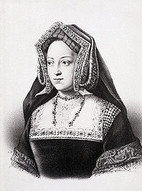 </a> </a>18th Century Engravings Katherine of Aragon many Portraits were done after her death, like many of other wives, ie. Anne Boleyn, Catherine Parr and Katherine Howard. |
| <a class="external" href="http://flickr.com/photos/pelegrino/460461745/" rel="nofollow" target="_blank" title="Katherine of Aragon">  </a> </a> Stained Glass Window of Katherine of Aragon from the beginning of her Reign. | <a class="external" href="http://flickr.com/photos/44124324682@N01/772480/" rel="nofollow" target="_blank" title="Katherine of Aragon.JPG"> 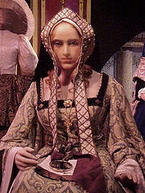 </a><a class="external" href="http://flickr.com/photos/22211466@N07/2233852909/" rel="nofollow" target="_blank" title="Catalina de Aragon Wax figure"> </a><a class="external" href="http://flickr.com/photos/22211466@N07/2233852909/" rel="nofollow" target="_blank" title="Catalina de Aragon Wax figure">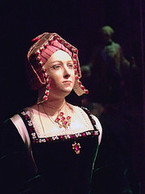 </a> </a> Wax Figures of Katherine of Aragon, to the left is Katherine of Aragon when she was more young, probably c.1502-1509 by the time she suffered the death of Prince Arthur or the time she was married to Henry, on the right is a copy of Katherine's Portrait by the time she and Henry drew apart from each other, c.1525-26? |
| Statue of a young Katherine. It was erected in 2007 and is located in the Plaza de las Bernardas, Salamanca, Spain. (her homeland | Katherine was indeed a beloved woman in her reign,William Shakespeare described her as "The Queen of Earthly Queens". Catherine's contemporaries said that she was "more beloved than any queen who ever reigned".Over the years, numerous artistic and cultural works have been dedicated to her, written about her, or mentioned her, including some by her husband Henry VIII, who wrote "Grene growth the holy" about and for her, and Juan Luis Vives, who dedicated "The Education of Christian Women" to her.(as you can see below). Every year at Peterbourgh Cathedral there is a service in her memory. On the service commemorating the 470th anniversary of her death, the Spanish Ambassador to the United Kingdom attended. The service started with a procession, led by the Mayor, Peterbourgh from the town hall, invited guests then joined the parade en route, before taking up their position in the Cathedral, music was played by pupils from the King's School, and a trumpet heralded the start of the procession, then as they entered the Cathedral, music was played from the restored organ. After the service, people were able to view portraits of Catherine of Aragon drawn by local schoolchildren for an art competition, which the ambassador then judged. There is a statue of her in her birthplace of Alcalá de Henares, as a young woman holding a book and a rose. |
Poem by King Henry VIII probably written for Queen Katherine Green groweth the holly, So doth the ivy. Though winter blasts blow never so high, Green groweth the holly. As the holly groweth green And never changeth hue, So I am, ever hath been, Unto my lady true. As the holly groweth green With ivy all alone When flowers cannot be seen And greenwood leaves be gone, Now unto my lady Promise to her I make, From all other only To her I me betake. Adieu, mine own lady, Adieu, my special Who hath my heart truly Be sure, and ever shall. | Queen Katherine's Cross Located in Ampthill Park, England. This cross marks where Ampthill Castle stood. When Katherine was sent from court in 1531, she lived in Ampthill Castle, then in 1533 Katherine was sent to the rotting Kimbolton Castle. In 1770, Lord Ossory had a memorial to Katherine made. The inscription at the base of monument reads: "In day's of old here Ampthill's towers were seen, The mournful refuge of an injured Queen; Here flowed her pure but unavailing tears, Here blinded zeal sustain'd her sinking years. Yet Freedom hence her radiant banner wav'd, And Love aveng'd a realm by priests enslav'd; From Catherine's wrongs a nation's bliss was spread. |
| Your daughter Mary will read these recommendations and will reproduce to them she models herself on your goodness and wisdom ... Therefore, all women will have an example to follow in your life and actions, and in this work dedicated to you, precepts and rules for the conduct of their lives. Spanish humanistic Juan Luis Vives's 1524 publication De institution Feminae Christianae, "The Education of A Christian Woman" A manual commissioned Queen Katherine and dedicated to her daughter Mary (the dedication stylized her as the Princess of Wales) but addressing the educational and spiritual needs of all women of rank and privilege. During his stays in England, Vives was a friend a spiritual counselor to Katherine. |
